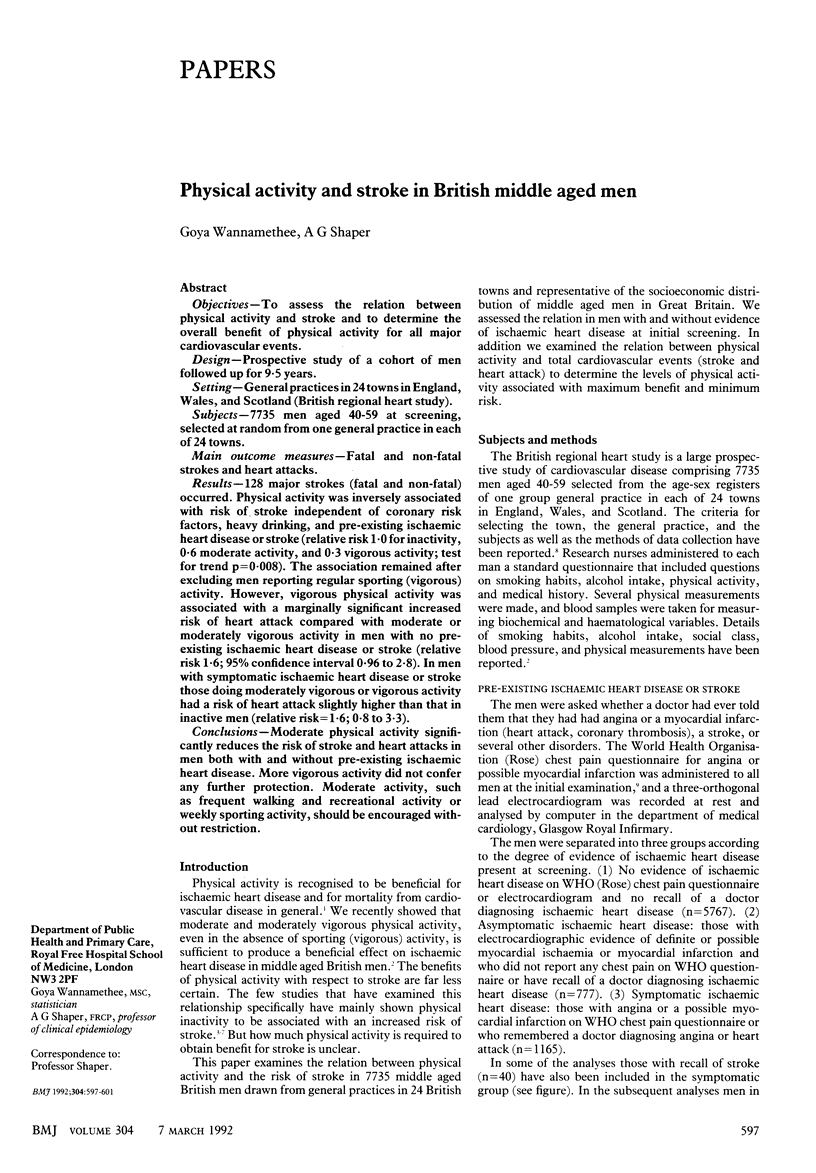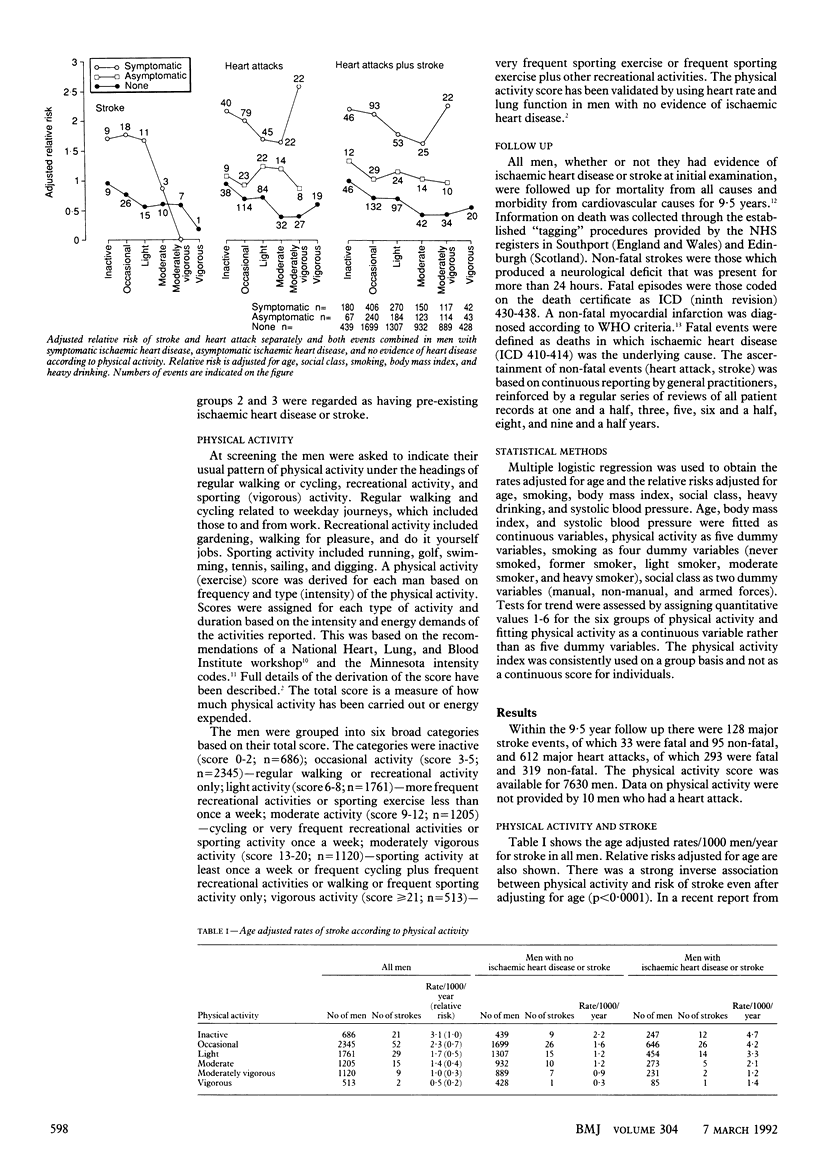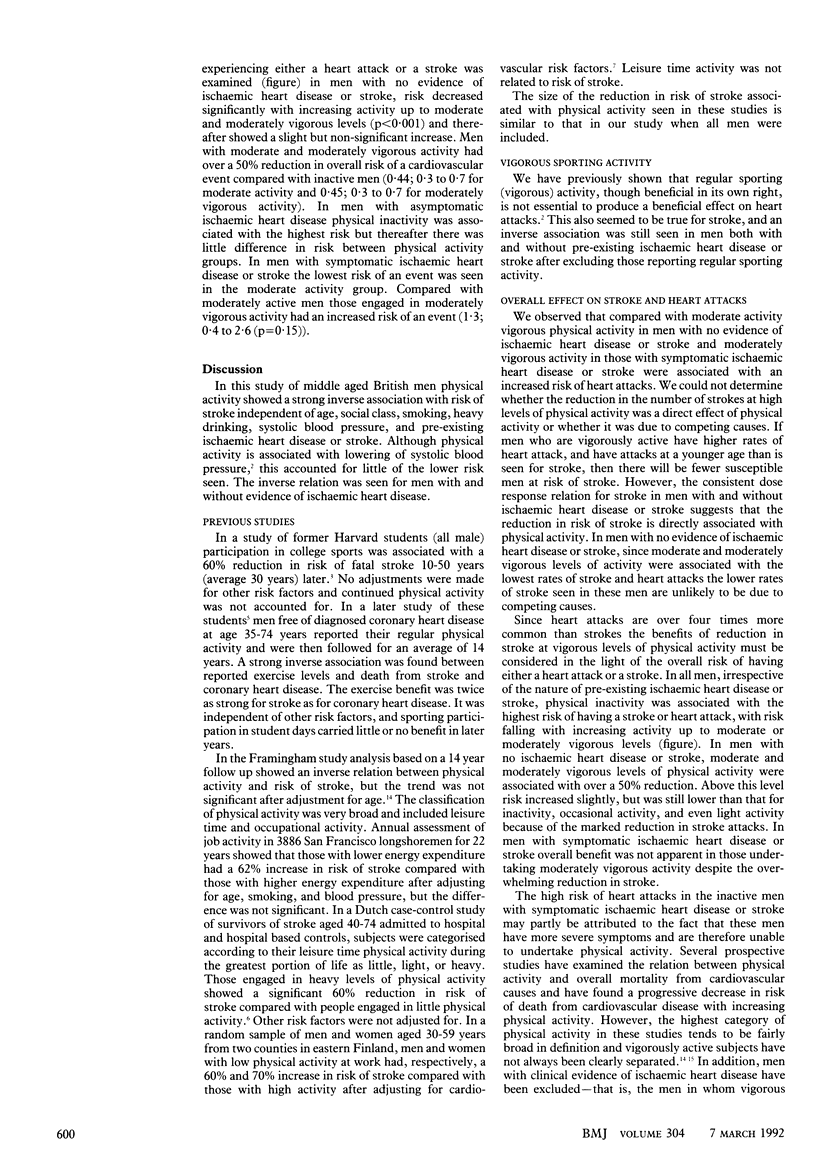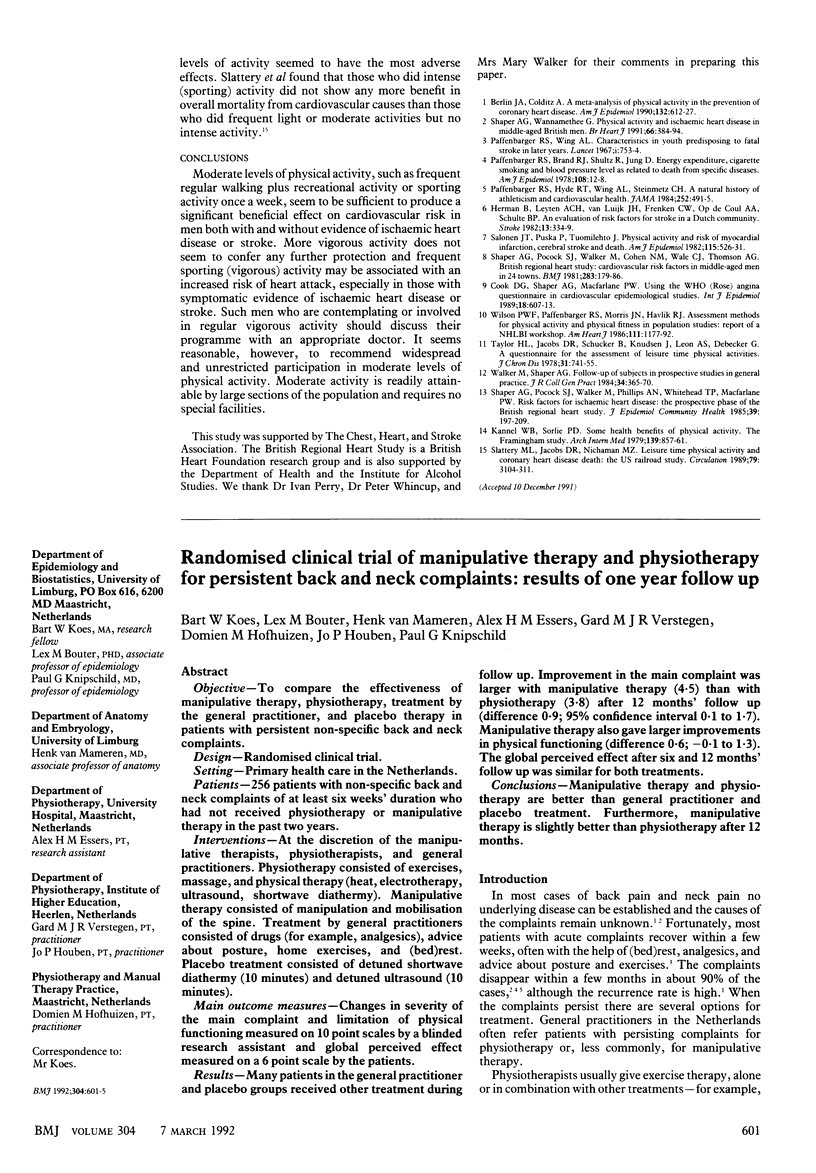Abstract
OBJECTIVES--To assess the relation between physical activity and stroke and to determine the overall benefit of physical activity for all major cardiovascular events. DESIGN--Prospective study of a cohort of men followed up for 9.5 years. SETTING--General practices in 24 towns in England, Wales, and Scotland (British regional heart study). SUBJECTS--7735 men aged 40-59 at screening, selected at random from one general practice in each of 24 towns. MAIN OUTCOME MEASURES--Fatal and non-fatal strokes and heart attacks. RESULTS--128 major strokes (fatal and non-fatal) occurred. Physical activity was inversely associated with risk of stroke independent of coronary risk factors, heavy drinking, and pre-existing ischaemic heart disease or stroke (relative risk 1.0 for inactivity, 0.6 moderate activity, and 0.3 vigorous activity; test for trend p = 0.008). The association remained after excluding men reporting regular sporting (vigorous) activity. However, vigorous physical activity was associated with a marginally significant increased risk of heart attack compared with moderate or moderately vigorous activity in men with no pre-existing ischaemic heart disease or stroke (relative risk 1.6%; 95% confidence interval 0.96 to 2.8). In men with symptomatic ischaemic heart disease or stroke those doing moderately vigorous or vigorous activity had a risk of heart attack slightly higher than that in inactive men (relative risk = 1.6; 0.8 to 3.3). CONCLUSIONS--Moderate physical activity significantly reduces the risk of stroke and heart attacks in men both with and without pre-existing ischaemic heart disease. More vigorous activity did not confer any further protection. Moderate activity, such as frequent walking and recreational activity or weekly sporting activity, should be encouraged without restriction.
Full text
PDF




Selected References
These references are in PubMed. This may not be the complete list of references from this article.
- Berlin J. A., Colditz G. A. A meta-analysis of physical activity in the prevention of coronary heart disease. Am J Epidemiol. 1990 Oct;132(4):612–628. doi: 10.1093/oxfordjournals.aje.a115704. [DOI] [PubMed] [Google Scholar]
- Cook D. G., Shaper A. G., MacFarlane P. W. Using the WHO (Rose) angina questionnaire in cardiovascular epidemiology. Int J Epidemiol. 1989 Sep;18(3):607–613. doi: 10.1093/ije/18.3.607. [DOI] [PubMed] [Google Scholar]
- Herman B., Leyten A. C., van Luijk J. H., Frenken C. W., Op de Coul A. A., Schulte B. P. An evaluation of risk factors for stroke in a Dutch community. Stroke. 1982 May-Jun;13(3):334–339. doi: 10.1161/01.str.13.3.334. [DOI] [PubMed] [Google Scholar]
- Kannel W. B., Sorlie P. Some health benefits of physical activity. The Framingham Study. Arch Intern Med. 1979 Aug;139(8):857–861. [PubMed] [Google Scholar]
- Paffenbarger R. S., Jr, Hyde R. T., Wing A. L., Steinmetz C. H. A natural history of athleticism and cardiovascular health. JAMA. 1984 Jul 27;252(4):491–495. [PubMed] [Google Scholar]
- Paffenbarger R. S., Jr, Wing A. L. Characteristics in youth predisposing to fatal stroke in later years. Lancet. 1967 Apr 8;1(7493):753–754. doi: 10.1016/s0140-6736(67)91367-0. [DOI] [PubMed] [Google Scholar]
- Salonen J. T., Puska P., Tuomilehto J. Physical activity and risk of myocardial infarction, cerebral stroke and death: a longitudinal study in Eastern Finland. Am J Epidemiol. 1982 Apr;115(4):526–537. doi: 10.1093/oxfordjournals.aje.a113334. [DOI] [PubMed] [Google Scholar]
- Shaper A. G., Pocock S. J., Walker M., Cohen N. M., Wale C. J., Thomson A. G. British Regional Heart Study: cardiovascular risk factors in middle-aged men in 24 towns. Br Med J (Clin Res Ed) 1981 Jul 18;283(6285):179–186. doi: 10.1136/bmj.283.6285.179. [DOI] [PMC free article] [PubMed] [Google Scholar]
- Shaper A. G., Pocock S. J., Walker M., Phillips A. N., Whitehead T. P., Macfarlane P. W. Risk factors for ischaemic heart disease: the prospective phase of the British Regional Heart Study. J Epidemiol Community Health. 1985 Sep;39(3):197–209. doi: 10.1136/jech.39.3.197. [DOI] [PMC free article] [PubMed] [Google Scholar]
- Shaper A. G., Wannamethee G., Weatherall R. Physical activity and ischaemic heart disease in middle-aged British men. Br Heart J. 1991 Nov;66(5):384–394. doi: 10.1136/hrt.66.5.384. [DOI] [PMC free article] [PubMed] [Google Scholar]
- Slattery M. L., Jacobs D. R., Jr, Nichaman M. Z. Leisure time physical activity and coronary heart disease death. The US Railroad Study. Circulation. 1989 Feb;79(2):304–311. doi: 10.1161/01.cir.79.2.304. [DOI] [PubMed] [Google Scholar]
- Taylor H. L., Jacobs D. R., Jr, Schucker B., Knudsen J., Leon A. S., Debacker G. A questionnaire for the assessment of leisure time physical activities. J Chronic Dis. 1978;31(12):741–755. doi: 10.1016/0021-9681(78)90058-9. [DOI] [PubMed] [Google Scholar]
- Walker M., Shaper A. G. Follow-up of subjects in prospective studies based in general practice. J R Coll Gen Pract. 1984 Jul;34(264):365–370. [PMC free article] [PubMed] [Google Scholar]


